

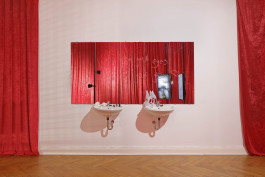
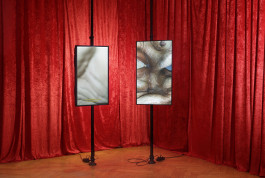

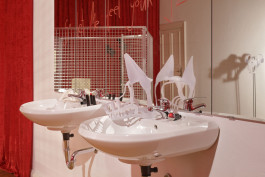
A series of organic cut-out drawings on nettle fabric has been attached to it much like the band patches on the frocks of music fans. The illustrations, taken from reference books, depict chains and torture devices as well as masks of shame that were used in the 17th century to punish so-called crimes of honor, such as gossip, with public scorn. Transferred to the patches and attached to the denim material of everyday fashion, the images here become historical brands of female oppression. Transposed from a 3D print into the physical present, the mask laid aside in the sink finally permits us to visualize the idea of a woman removing her grotesque face covering before going to bed after a day of ridicule. (1) The word “gossip” has been used since early modern times to describe empty, lurid talk and, with its feminine connotations, devalues conversations between women in particular. In its origins, however, the Old English word meant “godsibb” godmothers or a good, usually female friend. After we have searched the private chambers of the exposed with a voyeuristic gaze, we encounter a video work at the end of the exhibition that examines the witch masks initially mentioned in a jerky tracking shot at close range. The gloomy sound that lingers over the two-channel installation can be suggestive of the many transfiguring witch stories from movies. Yet, together with the previously seen drawings of the torture devices, associations with the crime of witch hunts are evoked. The narrative framework of the work is set by a conversation the artist had with a friend about self-experienced injustices in the art field. The reflective final part can be read in inserted subtitles, which deals with the impossibility of publicizing this kind of very intimate conversation between women. Consequently, it reappropriates the concept of “gossip”, which has been displaced for centuries, in reversion to its original positive meaning, and marks it self-empoweringly as a safe space. Without diminishing the urgency of the research displayed throughout the exhibition space, Rebekka Benzenberg manages to lift the overwhelming weight of the subject. The works intellectually informed by history books and essays are complemented by a multitude of quick drawings and text works with impulsively selected song lines. Taken from her favorite songs and transferred to denim and nettle fabric, we encounter the catchy phrases on walls, kennels, and freestanding in space. As an expression of one’s attitude to life with a simultaneous offering of identification, the music serves here as a storehouse of emotion and, after all, provides hope and courage for a better future.
Text: Sebastian Peter Translation: Lena Stewens

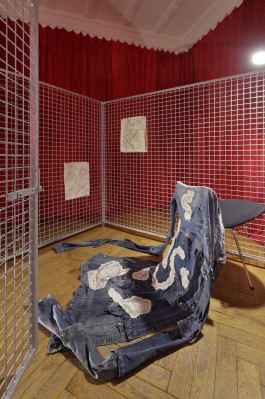



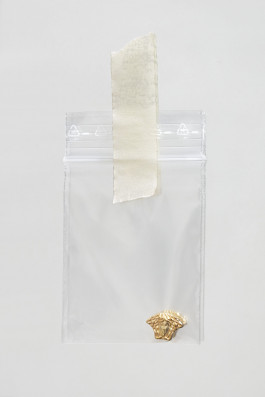




A series of organic cut-out drawings on nettle fabric has been attached to it much like the band patches on the frocks of music fans. The illustrations, taken from reference books, depict chains and torture devices as well as masks of shame that were used in the 17th century to punish so-called crimes of honor, such as gossip, with public scorn. Transferred to the patches and attached to the denim material of everyday fashion, the images here become historical brands of female oppression. Transposed from a 3D print into the physical present, the mask laid aside in the sink finally permits us to visualize the idea of a woman removing her grotesque face covering before going to bed after a day of ridicule. (1) The word “gossip” has been used since early modern times to describe empty, lurid talk and, with its feminine connotations, devalues conversations between women in particular. In its origins, however, the Old English word meant “godsibb” godmothers or a good, usually female friend. After we have searched the private chambers of the exposed with a voyeuristic gaze, we encounter a video work at the end of the exhibition that examines the witch masks initially mentioned in a jerky tracking shot at close range. The gloomy sound that lingers over the two-channel installation can be suggestive of the many transfiguring witch stories from movies. Yet, together with the previously seen drawings of the torture devices, associations with the crime of witch hunts are evoked. The narrative framework of the work is set by a conversation the artist had with a friend about self-experienced injustices in the art field. The reflective final part can be read in inserted subtitles, which deals with the impossibility of publicizing this kind of very intimate conversation between women. Consequently, it reappropriates the concept of “gossip”, which has been displaced for centuries, in reversion to its original positive meaning, and marks it self-empoweringly as a safe space. Without diminishing the urgency of the research displayed throughout the exhibition space, Rebekka Benzenberg manages to lift the overwhelming weight of the subject. The works intellectually informed by history books and essays are complemented by a multitude of quick drawings and text works with impulsively selected song lines. Taken from her favorite songs and transferred to denim and nettle fabric, we encounter the catchy phrases on walls, kennels, and freestanding in space. As an expression of one’s attitude to life with a simultaneous offering of identification, the music serves here as a storehouse of emotion and, after all, provides hope and courage for a better future.
Text: Sebastian Peter Translation: Lena Stewens






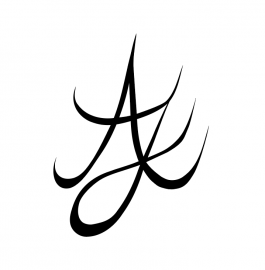
Anton Janizewski Galerie,
Anton Janizewski Galerie,